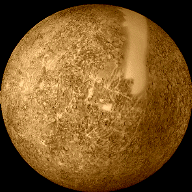

|
Astronomy 161:
An Introduction to Solar System Astronomy
Prof. Richard Pogge, MTWThF 2:30
|
Lecture 33:

Battered Mercury
Key Ideas:
Mercury is the innermost planet
Rotation is locked in a 3:2 resonance with the Sun
Surface:
- Heavily cratered
- virtually no atmosphere
Interior:
- Large iron core & weak magnetic field.
- Weak tectonic activity (wrinkles as it cools)
Mercury at a Glance
- Orbital Data
- Semi-Major Axis: a = 0.386 AU
- Orbital Period: P = 87.969 days
- Eccentricity: e = 0.206
- Perihelion: 0.31 AU
- Aphelion: 0.47 AU
- Inclination: i = 7° (Most elliptical orbit of the planets)
- Planetary Data
- Radius: R = 2439 km (0.382 REarth)
- Mass: M = 0.055 MEarth
- Rotation Period: 58.65 days, exactly 2/3 of its orbital Period.
Mercury's Day is 176d long as a consequence
- Axis Tilt: 2°
Resonant Rotation
Mercury's rotation period is exactly 2/3 its orbital period.
- In a 3:2 Spin-Orbit Resonance with the Sun.
- Completes 3 rotations for every 2 orbits.
Caused by its elliptical orbit:
- Tides are strongest at perihelion (closest to Sun)
- Result is a rotation period that is the same as it would
have if it were in a circular orbit at its perihelion
distance and tidally locked to the Sun.
Spacecraft Visits to Mercury
Only one spacecraft has ever visited Mercury. The US Mariner 10
spacecraft flew past Mercury 3 times in 1974 and 1975. The timing of
the fly-bys was such that only 45% of the surface was in sunlight, so
more than half the planet has never been imaged up close.
The NASA Discovery-class spacecraft Messenger was launched in
August 2004. Using one Earth flyby in 2005 and two Venus flybys in 2006
and 2007 for gravity assistance, it will first flyby Mercury 3 times,
twice in 2008 and once in 2009, timed so as to be able to map the entier
surface of the planet. In March 2011 it will go into orbit around
Mercury and begin an extended close-up study mission. The first fly-by
will be 2008 January 14 when it will pass within 200km of Mercury.
For more info, see the Messenger
website.
A future ESA/Japanese spacecraft, Bepi-Columbo, is currently in the
planning stages, approved for a 2008-2013 mission window.
Surface of Mercury
Mercury is heavily cratered, like the Moon.
- Surface is ~3.8-4 Gyr old, like the lunar highlands
(last epoch of heavy bombardment)
- Craters are flatter than lunar craters because
Mercury's gravity is 2x stronger.
Terrain Features:
- Highlands & lava basins, like the Moon
- Caloris Basin: Huge ringed impact basin.
- Lobate scarps & jumbled terrain.
Caloris Basin
Impact Basin: Made by a large asteroid impact.
- Punched into the crust
- Left a huge ringed basin 1340 km in diameter
Antipodes: (opposite side of Mercury from the Caloris Basin)
- Jumbled terrain where seismic waves all converged.
Mercury's Atmosphere
Mercury has virtually no atmosphere:
- Pressure 10-12 that of Earth's
atmosphere.
- Thin wisps of H and He captured from the Solar Wind.
- Atoms of Sodium & Calcium knocked out of rocks by
energetic solar wind particles.
Lost its primordial atmosphere:
- Gravity is too small to hold onto it
- Too close to the Sun (higher temperatures)
Surface Temperatures
Since Mercury has virtually no atmosphere, there are extreme Day/Night
temperatures:
- Daytime: 500 K (441º F)
- Nighttime: 100K (-279º F)
- Some daytime locations are as hot as 600K.
Poles are in perpetual twilight:
- Axis has virtually no tilt.
- Polar soil is cold: 125 K (-234º F)
Mercury's Interior
Mercury is intermediate in size between the Moon and Mars. We expect:
- Thinner lithosphere than the Moon, but
- Thicker than Earth or Mars
See lobate scarps, signs of tectonic disturbance (but NOT plate
tectonics):
- Lobate scarps mark thrust faulting.
- The lithosphere wrinkles as Mercury's interior cools and contracts.
Deep Interior
Rocky mantle is about 700 km thick.
Unexpectedly large iron core:
- 75% of the radius of Mercury!
- Contains ~60% of the planet's mass.
Revealed by:
- Weak Magnetic Field: ~1% as strong as Earth's
- High average density: 5.43 g/cc, compared with Mars which
is bigger but only 3.9 g/cc.
How did Mercury get such a huge core?
One idea is that during formation Mercury collided nearly head-on with a
large body.
- Collider was smaller than Mercury
- Impact blew off most of Mercury's mantle.
- Re-formed planet had a huge iron core left behind.
The weak magnetic field is due to a molten core:
- Weak Dynamo: fluid motions in a semi-molten core generate a magnetic
field.
- Molten core revealed by wobbles in Mercury's rotation that are
larger than if the core was solid.
- Core is still molten because it is rich in sulfur, which
lowers the melting point compared to a pure iron core.
Planetary Impacts
Once again, we see how impacts between planets and asteroid-sized bodies
can play an important role in determining a planet's properties.
- In the case of Mercury, a large head-on impact is invoked
to explain its unusually large iron core.
Impacts are an essential element of the history of the Solar System.
Return to [
Unit 6 Index
|
Astronomy 161 Main Page
]
Updated: 2007 November 4
Copyright © Richard W. Pogge,
All Rights Reserved.
